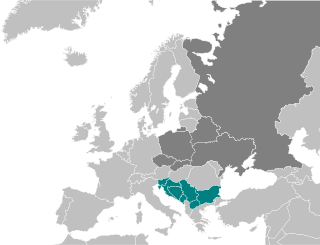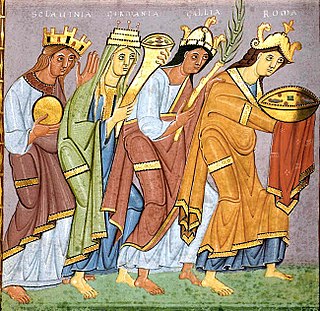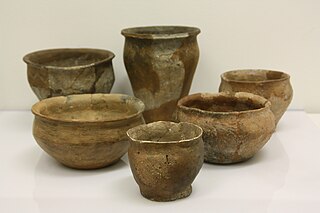The Slavs or Slavic people are an ethnolinguistic grouping of related ethnic groups which speak the various Slavic languages, belonging to the larger Balto-Slavic branch of the Indo-European language family. Slavs are geographically distributed throughout the northern parts of Eurasia; they predominantly inhabit Central Europe, Eastern Europe, and Southeastern Europe, though there is a large Slavic minority scattered across the Baltic states, Northern Asia, and Central Asia. Continued immigration has resulted in the development of a substantial Slavic diaspora in the Americas, Western Europe, and Northern Europe including the United States, United Kingdom, Canada, Ireland, Norway, Mexico, Brazil, Argentina and Chile.

The East Slavs are the most populous subgroup of the Slavs. They speak the East Slavic languages, and formed the majority of the population of the medieval state Kievan Rus', which they claim as their cultural ancestor. Today Belarusians, Russians and Ukrainians are the existent East Slavic nations. Rusyns can also be considered as a separate nation, although they are often considered a sub-group of the Ukrainian people.
The Vistula Veneti, also called Baltic Veneti were an Indo-European peoples that inhabited the lands of central Europe east of the Vistula River and the Bay of Gdańsk. First mentioned in the 1st century AD by ancient Roman geographers who differentiated a group of peoples whose manner and language differed from that of the neighbouring Germanic and Sarmatian tribes. In the 6th century AD, Byzantine historians described the Veneti as the ancestors of the Slavs who during the second phase of the Migration Period crossed the northern frontiers of the Byzantine Empire.

The Przeworsk culture was an Iron Age material culture in the region of what is now Poland, that dates from the 3rd century BC to the 5th century AD. It takes its name from the town Przeworsk, near the village where the first artifacts were identified.

The White Croats, also known simply as Croats, were a group of Early Slavic tribes that lived among other East Slavic and West Slavic tribes in the historical region of Galicia north of the Carpathian Mountains, in modern Western Ukraine, Lesser Poland, Eastern Slovakia, and possibly Northeastern Bohemia.

South Slavs are Slavic people who speak South Slavic languages and inhabit a contiguous region of Southeast Europe comprising the eastern Alps and the Balkan Peninsula. Geographically separated from the West Slavs and East Slavs by Austria, Hungary, Romania, and the Black Sea, the South Slavs today include Bosniaks, Bulgarians, Croats, Macedonians, Montenegrins, Serbs and Slovenes.

The Sclaveni or Sklabenoi were early Slavic tribes that raided, invaded and settled in the Balkans in the Early Middle Ages and eventually became one of the progenitors of modern South Slavs. They were mentioned by early Byzantine chroniclers as barbarians having appeared at the Byzantine borders along with the Antes, another Slavic group. The Sclaveni were differentiated from the Antes and Wends ; however, they were described as kin. Eventually, most South Slavic tribes accepted Byzantine or Frankish suzerainty, and came under their cultural influences and Chalcedonian Christianity. The term was widely used as a general catch-all term until the emergence of separate tribal names by the 10th century.

The most important phenomenon that took place within the lands of Poland in the Early Middle Ages, as well as other parts of Central Europe was the arrival and permanent settlement of the West Slavic or Lechitic peoples. The Slavic migrations to the area of contemporary Poland started in the second half of the 5th century AD, about a half century after these territories were vacated by Germanic tribes fleeing from the Huns. The first waves of the incoming Slavs settled the vicinity of the upper Vistula River and elsewhere in the lands of present southeastern Poland and southern Masovia. Coming from the east, from the upper and middle regions of the Dnieper River, the immigrants would have had come primarily from the western branch of the early Slavs known as Sclaveni, and since their arrival are classified as West Slavs and Lechites, who are the closest ancestors of Poles.
The settlement of the Eastern Alps region by early Slavs took place during the 6th to 8th centuries. It is part of the southward expansion of the early Slavs which would result in the characterization of the South Slavic group, and would ultimately result in the ethnogenesis of present-day Slovenes. The Eastern Alpine territories concerned comprise modern-day Slovenia, Eastern Friuli, in modern-day Northeast Italy, and large parts of modern-day Austria.

The Antes, or Antae, were an early East Slavic tribal polity of the 6th century CE. They lived on the lower Danube River, in the northwestern Black Sea region, and in the regions around the Don River. Scholars commonly associate the Antes with the archaeological Penkovka culture.

The early Slavs were an Indo-European peoples who lived during the Migration Period and the Early Middle Ages in Central, Eastern and Southeast Europe and established the foundations for the Slavic nations through the Slavic states of the Early and High Middle Ages. The Slavs' original homeland is still a matter of debate due to a lack of historical records; however, scholars believe that it was in Eastern Europe, with Polesia being the most commonly accepted location.

The Penkovka culture is an archaeological culture in Ukraine, Moldova and reaching into Romania. Its western boundary is usually taken to at the middle Prut and Dniester rivers, where contact with the Korchak culture occurs. Its bearers are commonly identified as the Antes people of 6th-century Byzantine historiography.
The Korchak culture is an archaeological culture of the sixth and seventh century East Slavs who settled along the southern tributaries of the Pripyat River and from the Dnieper River to the Southern Bug and Dniester rivers, throughout modern-day northwestern Ukraine and southern Belarus.
Slavs began migrating to Southeastern Europe in the mid-6th century and first decades of the 7th century in the Early Middle Ages. The rapid demographic spread of the Slavs was followed by a population exchange, mixing and language shift to and from Slavic.
The Slavic ethnonym, Slavs, is reconstructed in Proto-Slavic as *Slověninъ, plural Slověně. The earliest written references to the Slav ethnonym are in other languages.

The Ipotești–Cândești culture was an archaeological culture in Eastern Europe. It developed in the mid-6th century by the merger of elements of the Prague-Penkovka and Prague-Korchak cultures and local cultures in the area between Prut and Lower Danube. It stretched in the Lower Danube over territory in Romania and Moldova. The population of the area was mostly made up of Early Slavs. There are views that it derived from the Chernyakhov culture and represented a group of the Antes, but also mixed with Sclaveni. The houses were identical to the Slavic huts of the Prague-Korchak and Penkovka areas. The sites in Romania are known as Ipotești-Candești-Ciurel or Ipotești-Ciurel-Cândești.

The Sukow or Sukow-Dziedzice group or Sukow-Dziedzice culture, also known as Szeligi culture, was an archaeological culture attributed to the Early Slavs. Areal of sites lays between Elbe and Vistula rivers in Northeast Germany and North West Poland. The earliest sites usually date to the second half of 7th and mid-8th centuries.

Volyntsevo culture or Volyntseve culture is an archaeological culture of the early Middle Ages, located between the Dnieper and the Don rivers. In the west, the territory of the Volyntsevo monuments reaches the right bank of Dnieper in the Kyiv area. Dmytro Berezovets identified the culture, and named it after the village of Volyntseve in Sumy Oblast of Central Ukraine, which he excavated in 1948–1950.

The Leipzig group in archaeology refers to the Slavic pottery from the Early to High Middle Ages in the Elbe-Saale area in today's state of Saxony, Saxony-Anhalt and Thuringia. It has four ceramic sub-groups or phases named after the eponymous sites of Rüssen, Rötha, Groitzsch and Kohren. It derives from Prague-Korchak culture. The group's area is considered to roughly correlate to the area of the Early Slavic tribe of Sorbs situated in Elbe-Mulde-Saale rivers valley.
Topical outline of articles about Slavic history and culture. This outline is an overview of Slavic topics; for outlines related to specific Slavic groups and topics, see the links in the Other Slavic outlines section below.










